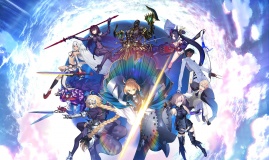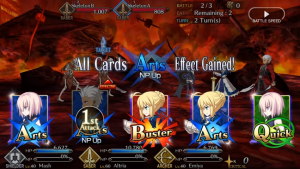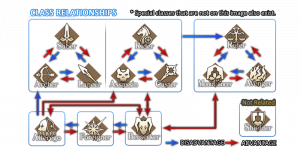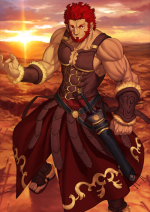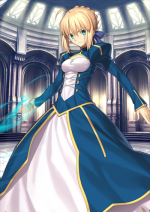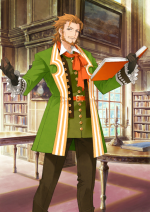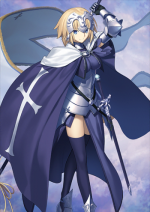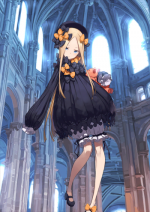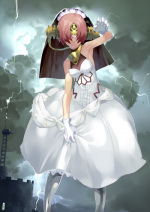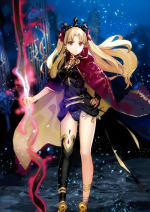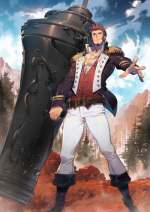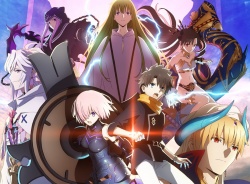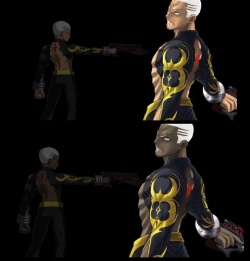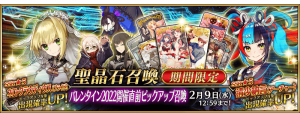Fate/Grand Order
| Genre | Tactical role-playing game |
| Gamming Style | Mobile |
| Platform | Android, iOS |
| Release Date | 2015-Present |
| Developer | Delightworks |
| Publisher | Aniplex |
| Website | Fate/Grand Order Official USA Website |
Fate/Grand Orderis a mobile RPG game developed by Delightworks and published by Aniplex on July 30, 2015, for the Android platform in Japan. An iOS release version followed on August 12, 2015. Over the years, the game was released across various countries including the United States, Canada, China, and Korea. The game is free-to-play and includes the gacha mechanic where players can spend real money to obtain additional in-game items through chances. By August 2021, the game had generated about $5.5 billion, putting it in fourth place on the top-grossing mobile games of the month. [1] There are also multiple manga, anime, and movie adaptations being continually released.
The game uses 2D visuals and texts to tell a story of where the main character, Ritsuka Fujimaru, travels back to various timelines for humanity’s survival. Players of the game will role-play as the “Master” and control “Servants” to fight in battles through different types of Command Cards. The Servants will take turns with the enemies to attack until HP reaches 0. These Servants are often based on famous historical or legendary figures and use an exact name as those figures. There is no PVP or direct competition between players within the game, so the players will always fight against enemies controlled by the computer. [2]
The portrayal of Servants that relate to historical characters from other cultures along with the time setting of the in-game event causes ethical concerns on Twitter and censorship of characters’ visuals in China. Some controversies of the game also rises with its gacha system and its low percent chance of obtaining rare Servants.
Gameplay
Combat
In Fate/Grand Order, the main gameplay performs through turn-based combat. Before a battle, the player chooses a party consisting of 6 Servants, with one of the slots being a support unit from a friend. 3 of the party members will be active for battle while the other 3 will be in reserve. In the preparation phase of the battle, players can check on the Servant status and tap to activate Servant Active Skills, Command Spells, or Master Skills. [3]
Master Skills provide short effects to strengthen Servants and depend on the player's choice of Mystic Codes, a tool to support the use of magic. Command Spells have a more powerful effect but require 24 hours to recharge. A player can only hold onto a maximum of three charges. Using one charge of Command Spells can heal Servants or charge their Noble Phantasm. If three charges of Command Spells are used, the player can revive the entire party with charged Noble Phantasm.
Afterward, the player clicks on the Attack button to obtain 5 randomly distributed Command Cards, then chooses 3 out of the 5 cards in a specific order. The Command Cards have 3 types, which are Arts, Buster, and Quick. Each card corresponds to one of the active Servants, who will be performing the action of the card. There will be a total of 15 cards in the pool, with each of the 3 Servants providing 5 cards. The first card that the player chooses will provide a bonus to other cards based on their type. When 3 cards of the same type are picked, there are additional effects known as Arts Chain, Quick Chain, or Buster Chain depending on the card type. If 3 cards correspond to the same Servant, then it triggers another effect called Brave Chain. A battle animation will play once the player decides on the cards. Aside from the 3 standard Command Cards, the player can also charge up Noble Phantasm, an ultimate ability. Once the Noble Phantasm fully charges, it will show up as an additional card to choose from aside from the 5 random cards. [4]
Servants
Servants are unique characters in-game for the player to control. They are not human but rather spirits that achieve a heroic status with stories told by people. These Servants can be historical figures, gods, or fictional monsters. Some examples include Achilles, William Shakespeare, Leonardo Da Vinci, and Frankenstein. Every Servant has a Class, Noble Phantasm, and various skills. There are 7 main classes (Saber, Archer, Lancer, Rider, Caster, Assassin, and Berserker) as well as 7 extra classes (Ruler, Avenger, Moon Cancer, Alter Ego, Foreigner, and Pretender). Classes can have advantages and disadvantages when going against certain other classes. Each Servant also has a different number of stars, ranging from 1 to 5. [5]
With the use of an Experience Card or the sacrifice of other Servants, Servants will be able to level up, increasing their attack and health point. Ascension is available once the Servants reach their maximum level, which depends on the Servant’s number of stars. One ascension will increase the Servant’s maximum level by 10, and a total of 4 ascensions is allowed per Servant. Another purpose for the player to Ascend their Servants is to gain new skills. Ascending the Servants will also change their art and battle spirit. The methods of obtaining new Servants include in-game events and rolling the gacha system, which is often time-limited.
Some Examples of Servants in FGO
Noble Phantasm
Noble Phantasm is a unique attack that belongs to each Servant in the game. To use in combat, the player must first charge the NP bar, which is located below Servant’s health bar in the game interface. The form of Noble Phantasm can be physical such as swords, bows, and rings, or nonphysical like magical ability and curse. Noble Phantasm is also upgradable using duplicates of the same Servant up to a max level of 5.
Craft Essences
Craft Essences are cards that the player can put on Servants to grant bonus effects. These effects can be a simple increase in a Servant’s attributes or more complex ones that can affect the entire party or the Noble Phantasm. Similar to the Servants, Craft Essences are obtained from the in-game gacha system but have a higher percentage of getting compared to Servants. The upgrade method of Craft Essences is like the Servants’ Noble Phantasm, requiring the usage of the duplicating Craft Essences.
Influence Across Other Media
Anime
Fate/Grand Order: First Order is a 74-minutes animated film produced by Lay-duce studio. It was first aired in Japan on television on December 31, 2016. The protagonist, Ritsuka Fujimaru, who can be chosen to be male or female in the game, has a male appearance in the film. This adaptation is based on the prologue of the game, set in the year 2015. In the plot, the Chaldea Security Organization, a group that observes the world of magic and science, discovers the disappearance of humanity’s future in 2017. This is possible through Chaldeas, an invention representing the status of the world in both past and future. The cause of this is related to an unobserved region, Singularity, that took place in the town of Fuyugi in 2014. An unknown explosion in the base of Chaldea forces Ritsuka Fujimaru, along with a girl named Mash Kyrielight who becomes a Servant, to travel back in time to the land of Fuyugi. Their goal is to investigate and restore humanity’s existence. [6]
Fate/Grand Order - Absolute Demonic Front: Babylonia is an anime series produced by CloverWorks. In Japan, the series was aired from October 5, 2019, to March 16, 2020. There are 21 episodes plus a special episode as an adaptation of the seventh chapter of the game. The time of the story sets after Ritsuka and Mash have resolved 6 Singularities plus Singularity F. Ritsuka and Mash will travel to 2655 B.C. where humans of Mesopotamia are on the edge of extinction with one city remaining, Uruk. This is due to the Three Goddess Alliance formed by Gorgon, Quetzalcoatl, and Ereshkigal, who are competing to see who can destroy humanity first. Ritsuka and Mash will partner with the leader of the city, King Gilgamesh, also known as the King of Heros, to fight against the Three Goddess Alliance.
Movie
Fate/Grand Order - Divine Realm of the Round Table: Camelot is a two-part movie adaptation of the game. The first part was released on December 5, 2020, from the Signal.MD studio while the second part was released on May 15, 2021, from the Production I.G studio. These two movies are based on the sixth chapter of the game called Camelot Singularity. Continuing the journey of resolving Singularities, Ritsuka and Mash travel back to Jerusalem in 1273 A.D. The surrounding area known as the Holy Land has become a huge wasteland with people forced away from their homes due to clashes between three groups, two of which should not have existed in this era. The three groups are the local’s mountain village, Sun-King Ozymandias’ kingdom, and the Lion King’s Knights of Round Table. While traveling, the two protagonists meet a one-armed knight named Bedivere, who previously served King Arthur. Together with Bediverere, they will attempt to solve this land of chaos. [7]
Fate/Grand Order: Final Singularity - Grand Temple of Time: Solomon is a 94 minutes long movie adaption of the game’s eighth and final chapter of Main Record 1. This movie was released on July 31, 2021, and produced by Cloverworks, the same studio that created Fate/Grand Order - Absolute Demonic Front: Babylonia. The setting of the story occurs in 2016 at the Time Temple. Ritsuka and Mash will face Solomon and his 72 Demon Gods, who are the root of all Singularities across 3000 years of history. Even with Ritsuka’s new power, the two struggle against the power of the Demon Gods. However, a Servant who proclaimed herself as Jeanne d'Arc makes a sudden appearance and summons familiar Servants into the Time Temple to aid Ritsuka and Mash. Ritsuka and Mash will work with the Servants they encountered from the previous time travels to defeat Solomon. [8]
Game On Other Platforms
Fate/Grand Order Arcade is an arcade version of the game released by Sega in Japan on July 26, 2018. On September 6, 2018, the game announced the player numbers had exceeded more than 300,000. [9] Unlike Fate/Grand Order, this arcade version is a 3D action fighting game where the player can control one Servant directly. The game also doesn’t have story dialogue similar to Fate/Grand Order and instead provides a brief summary through the loading screen. To get Servants and Craft Essences, players will need to summon using the gacha system like the mobile version. Servants and Craft Essences will be given to the player in a physical card, which the player will be able to load at the start of a battle using the deck reader. [10]
Fate/Grand Order VR feat. Mash Kyrielight is a virtual reality game available on PlayStation VR on December 6, 2017, in Japan. On February 26, 2019, Aniplex released the game in the U.S. with English voice acting. Players will be able to interact with Mash Kyrielight and Artoria Pendragon one-on-one throughout scripted events. [11]
Ethical Issues
Servant Skin Color Concerns
In February of 2019, the North American version of Fate/Grand Order released a visual redesign of a Servant named Emiya Alter that looked different from other regions. In the story, Emiya Alter’s skin turns dark as a result of overusing magic. Emiya Alter uses two handguns as his primary weapons. For the western version, this darkened skin has been whitened to avoid associating with the racist depiction of black face. A related line where another Servant named Tamamo-no-Mae calls Emiya Alter as Detroit Emiya is also rephrased to Edgy Emiya. Fans react to these changes differently on Twitter. Some users tweet positively to the changes while others believe this ignores the backstory and original design of the artist. [12]
Muniba Saleem from University of Michigan–Dearborn and Craig A. Anderson from Iowa State University experimented on the effect of stereotypes in video games. Two groups of participants are shown violent and nonviolent portrayals of stereotypical Arabs inside the video games. Saleem and Anderson say the results of their experiment suggest a potential increase in negative and aggressive attitudes toward Arabs, with the group that experienced the violent portrayals of Arabs having a stronger effect than the group playing nonviolent portrayals. [13]
Gacha System
Fate/Grand Order’s monetization model is categorized as freemium, which became popular in the 2000s due to the increasing cost of video game production and the spread of smartphones. [14] To acquire additional Servants and Craft Essences, the players need to spend Saint Quartz on the Banner, the gacha system in-game, for summoning. Saint Quartz is available through in-game purchases through real money or earned in-game. Contents within the gacha system will change every few weeks, resulting in certain Servants only being obtainable in a limited time. Limited time gacha system is common among mobile games. Soka University and Ochanomizu University analyzed 31 popular mobile games picked from among 2660 young Japanese during November 2013 and 26 of those games include a limited-time gacha. [15]
Researchers from Soka University and Ochanomizu University did a study on the long-term effects of in-game purchases such as limited-time gacha and normal gacha in relation to money usage of teenagers and young adults. The study found that exposure to a higher amount of limited-time gacha could increase a player’s future spending. However, for normal gacha, the lower the amount of exposure, the more likely the person is going to spend more money in the following months. Another analysis of the data is that there doesn’t seem to be a correlation between game addiction and a person’s use of money. [16]
From Fate/Grand Order’s gacha system, the summoning rate of the 5 stars Servants is 1% and the rate for 5 stars Craft Essences is 4%. From its initial release in July of 2015 to January of 2022, the method to summon the desired Servant depends on the luck of a player. According to The Wall Street Journal, a 31-years-old man named Diego has spent over $70,000 to obtain rare Servants in the game at the time of March 2018. Diego does not regret his decision, saying it’s worth it. Whenever Diego is awake, he plays the game during every possible moment, even during his meals. [17]
Heavy spenders similar to Diego are called “whales.” Game companies often target whales as a reliable source of revenue, according to Matthew Chew, a sociology associate professor from Hong Kong Baptist University. [18] Inside Chew’s book about sociological interpretation of the North American game industry, he mentioned Swrve's Mobile Games Monetization Report. This report showed that 50% of the in-app purchase revenue comes from 0.15% of the players. Overall, the number of users who spend money on in-app purchases is lower than 5% of the entire population. [19]
A study conducted by Seoul National University and Korea University attempts to understand the reasons associated with someone’s intention to buy in-app purchases. A positive association exists between play frequency and one’s intention to spend money. Social interaction is another factor that correlates to one’s buying intention similar to play frequency. Giving away free items could increase one’s intention of purchase regardless of whether the player is new to the game. Those who purchase once are also more likely to purchase again in the future. [20]
Similar gacha mobile games released after Fate/Grand Order such as Arknights, Genshin Impact, and Guardian Tales have a pity system that guarantees the rewards once a specific amount of money is spent. In January of 2022, the Japan version of the Fate/Grand Order introduced a new pity system, which guarantees to summon an SSR(5 stars Servant) on the 330 rolls. [21] This pity system is only valid before the player pulls the first SSR that corresponds to the specific gacha pool. For players wishing to obtain duplicates of the same SSR to upgrade the Servant’s Noble Phantasm, the pity system won’t work. Also, the pity counter on the number of rolls doesn’t carry over to the next Banner, meaning the counter resets to 0 when the limited-time gacha pool changes.
War Controversy in South Korea
On June 6 of 2018, Fate/Grand Order announced a new event called "Gudaguda Teito Seihai Kitan" (Gudaguda Imperial Capital Holy Grail Strange Story). This in-game event tells a story of the Japanese Imperial Army attempting to win a frictional war that takes place in 1945. 1945 is the same year as the end of World War II and the end of Japan’s dominance in Asia, which angers South Korea’s game communities. South Korean players view the event as a way to glorify Japan’s army in World War II. Another reason for the controversy is because the date of the announcement, June 6, is also the Memorial Day of South Korea. On Twitter, fans use the hashtag “#FGODirectorsShouldApologize” to express their upset, hoping the staff will give an apology. [22]
Censorship in China
China considers many of the arts of the Servant in Fate/Grand Order as overly sexualized, resulting in multiple edits on various characters’ appearances in 2017 such as the Servants Boudica, Shuten Dōji, and Mata Hari. Edits include cropping of portraits, covering more body parts, and removing the entire illustration. [23] [24] In September of 2021, the Chinese server of the game received another wave of censorship on a total of 13 Servants that connect to historical figures in China. The related Servants have changes in their voice, names, illustrations, and data. For example, the Servant Lu Bu, based on a popular general of the same name in the Three Kingdom period of Chinese history, received a new name called Berserker 049. The illustration changes also include complete replacement of the original, such as the art of Servant named Wu Zetian. [25]
Gender Binary
In Fate/Grand Order, there are two appearances, male or female, available to the player for the main character Ritsuka Fujimaru. The male version of Ritsuka has dark brown hair with blue eyes, and the female version has red hair with light orange eyes. The player can choose to switch between the male version and the female version at any time, but there aren’t options outside of the gender binary. In terms of the game’s gender representation of the Servants, there aren’t any Servants that are confirmed to have gender identity outside of the gender binary.
References
- ↑ Craig Chapple "Top Grossing Mobile Games Worldwide for August 2021" Retrieved on 11 February 2022.
- ↑ Brian C. Britt and Rebecca K. Britt"From waifus to whales: The evolution of discourse in a mobile game-based competitive community of practice" Retrieved on 11 February 2022.
- ↑ GrandOrderWiki. "GrandOrderWiki - Gameplay." Retrieved on 28 January 2022.
- ↑ GrandOrderWiki. "GrandOrderWiki - Command Cards" Retrieved on 28 January 2022.
- ↑ Fate/Grand Order Wiki. "Fate/Grand Order Wiki Servants" Retrieved on 28 January 2022.
- ↑ Fate/Grand Order: First Order Official USA Website. "Fate/Grand Order: First Order Official USA Website" Retrieved on 11 February 2022.
- ↑ Fate/Grand Order - Divine Realm of the Round Table: Camelot Official USA Website. Fate/Grand Order - Divine Realm of the Round Table: Camelot Official USA Website" Retrieved on 11 February 2022.
- ↑ Fate/Grand Order: Final Singularity - Grand Temple of Time: Solomon Official USA Website. "Fate/Grand Order: Final Singularity - Grand Temple of Time: Solomon Official USA Website" Retrieved on 11 February 2022.
- ↑ Fate/Grand Order Arcade Official JP Website. "【終了】「マスター30万人突破キャンペーン」開催!" Retrieved on 11 February 2022.
- ↑ Fate/Grand Order Arcade Official JP Website. "Fate/Grand Order Arcade Official JP Website." Retrieved on 11 February 2022.
- ↑ Fate/Grand Order VR feat. Mash Kyrielight Official USA Website. "Fate/Grand Order VR feat. Mash Kyrielight Official USA Website." Retrieved on 11 February 2022.
- ↑ Bounding Into Comics. "Fate/Grand Order Edits Emiya Alter Design for North American Release" Retrieved on 28 January 2022.
- ↑ Saleem Muniba and Anderson Craig A."Arabs as terrorists: Effects of stereotypes within violent contexts on attitudes, perceptions, and affect." Retrieved on 11 February 2022.
- ↑ Lies van Roessel and Jan Švelch."Who Creates Microtransactions: The Production Context of Video Game Monetization" Retrieved on 11 February 2022.
- ↑ Akiko Shibuya, Mizuha Teramoto, and Akiyo Shoun. "In-Game Purchases and Event Features of Mobile Social Games in Japan" Retrieved on 11 February 2022.
- ↑ Akiko Shibuya, Mizuha Teramoto, and Akiyo Shoun. "Long-Term Effects of In-Game Purchases and Event Game Mechanics on Young Mobile Social Game Players in Japan " Retrieved on 11 February 2022.
- ↑ The Wall Street Journal. "Meet the Man Who’s Spent $70,000 Playing a Mobile Game" Retrieved on 28 January 2022.
- ↑ Matthew M. Chew."Contested Reception of the Free-To-Play Business Model in the North American Video Game Market" Retrieved on 11 February 2022.
- ↑ Schick Shane "50% of in-app revenues come from 0.15% of users." Retrieved on 11 February 2022.
- ↑ Moonkyoung Jang, Rumi Lee and Byungjoon Yoo "Does fun or freebie increase in-app purchase?" Retrieved on 11 February 2022.
- ↑ Siliconera. "Fate/Grand Order Implements a Pity System in Gacha" Retrieved on 28 January 2022.
- ↑ AnimeNewsNetwork. "Fate/Grand Order Game's New Event Set in 1945 Stirs Controversy" Retrieved on 28 January 2022.
- ↑ Kotaku Australia. "China Keeps Censoring Fate/Grand Order Character Art" Retrieved on 28 January 2022.
- ↑ Crunchyroll. "China Takes Mata Hari and Boudica Down a Notch for 'Fate/Grand Order'" Retrieved on 28 January 2022.
- ↑ Siliconera. "Chinese Servants’ Art And Data Removed From CN Fate/Grand Order" Retrieved on 28 January 2022.

